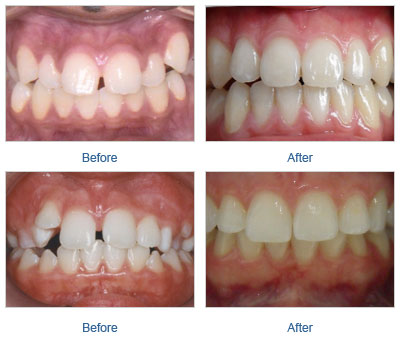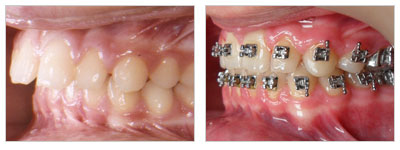Services
Orthodontic
 Orthodontics is a dental specialty that deals with the diagnoses, prevention, and correction of misaligned teeth and jaws. If left uncorrected, crooked teeth and misaligned bites can lead to abnormal function, headaches, sore jaw muscles, fractured teeth, and even tooth decay overtime. Besides these negative physiological impacts, one cannot overstate the negative psychological impacts. Additionally, contrary to popular belief, age is not a limiting factor in getting braces. Depending on the dental health profile and the severity of the misalignment, braces can be started early, around 8 years of age, when all four permanent molars and the front teeth have fully erupted, or, in our practice, as late as 78 years of age. Braces are not just for teenagers. In fact, over ONE MILLION North Americans over the age of 18 have braces.
Orthodontics is a dental specialty that deals with the diagnoses, prevention, and correction of misaligned teeth and jaws. If left uncorrected, crooked teeth and misaligned bites can lead to abnormal function, headaches, sore jaw muscles, fractured teeth, and even tooth decay overtime. Besides these negative physiological impacts, one cannot overstate the negative psychological impacts. Additionally, contrary to popular belief, age is not a limiting factor in getting braces. Depending on the dental health profile and the severity of the misalignment, braces can be started early, around 8 years of age, when all four permanent molars and the front teeth have fully erupted, or, in our practice, as late as 78 years of age. Braces are not just for teenagers. In fact, over ONE MILLION North Americans over the age of 18 have braces.
The training process to become sufficient in orthodontics is extremely rigid. I first completed 4 years of dental school. I then completed 3 more years of postdoctoral studies in orthodontics. I now have over 20 years of clinical experience. In other words, I am an EXPERT in creating beautiful well-functioning smiles.
On your consultation visit, expect to have your specific dental issues or needs evaluated and to receive a preliminary treatment plan. The definitive treatment plan can only be derived after a thorough evaluation of:
- Your study models (white stone replicas, which are made from the impressions of the upper and lower arches of your teeth). Fig. 1 and Fig. 2
- Your intra-oral and facial photographs.
- The tracings and angles generated from your cephalometric xray (a profile x-ray of your entire head).
Braces have 3 main components:
- Brackets that are attached to each tooth, and bands that are used to attach to molars.
- Hand elastics, available in multiple colors, that transfer the force from the arch wire to the brackets/bands, which in turn, effect the movement of your teeth.
- An arch wire that fits into the brackets/bands.
There are generally 3 varieties of braces available today:
- Metal braces are made of stainless steel and are the most popular kind of braces. Stainless steel is a sturdy material that will resist distortion and can be easily reattached to the tooth should it get accidentally get detached.
- Ceramic braces are clear in color and are less noticeable than metal braces. They are slightly larger in size and more prone to fracture. If they become detached, a new ceramic bracket must be used. are clear in color and are less noticeable than metal braces. They are slightly larger in size and more prone to fracture. If they become detached, a new ceramic bracket must be used.
- Invisible braces are clear plastic, removable trays, similar to clear retainers, that are the most discreet form of braces. From a computer model that is generated from impressions of your teeth, a sequence of trays are made that will slowly move your teeth toward the final goal. This form of orthodontics is very effective in certain cases. Its biggest disadvantage is patient compliance. You must diligently wear the trays for it to work.
It is a common misconception that once you get braces, you are extremely limited in what you can eat. The truth is: you can eat just about anything you like! There are a few exceptions, though. Biting into full apples, chewing gum, and eating chewy candies (caramel, gummy bears, taffy, etc.) can clog the wires and pull the brackets out of place.
Good oral hygiene is important for your dental health, but exceptional oral hygiene is required while under orthodontic treatment. More debris can stick to your teeth when you wear braces because there are more places for them to get lodged. Always floss and brush immediately after every meals. We will provide you with the proper instructions and a portable orthodontic toothbrush.
The Process
Depending on your treatment plan, you may get seperators, tiny little rubber bands inserted between your upper and lower molars, on your first orthodontic appointment. The seperators will create spaces for the bands to fit around each molar. Expect some soreness 6 to 8 hours following your visit, which may last up to 1 to 2 days. Your next appointment will be scheduled in 5 to 7 days. At this visit, bands will be cemented to your molars, and brackets will be attached to the rest of your upper teeth. Again, your teeth will be sore for a few days. Make sure you take appropriate over-the-counter pain medications to alleviate any pain. Rest assured, in terms of discomfort, you will not reach this level again throughout the rest of your treatment. We will then bracket your lower teeth 1 to 2 months or later after your upper teeth, depending on your dental conditions. Subsequent orthodontic appointments are usually spaced out at 1month intervals.
Expect some soreness 6 to 8 hours following your visit, which may last up to 1 to 2 days. Your next appointment will be scheduled in 5 to 7 days. At this visit, bands will be cemented to your molars, and brackets will be attached to the rest of your upper teeth. Again, your teeth will be sore for a few days. Make sure you take appropriate over-the-counter pain medications to alleviate any pain. Rest assured, in terms of discomfort, you will not reach this level again throughout the rest of your treatment. We will then bracket your lower teeth 1 to 2 months or later after your upper teeth, depending on your dental conditions. Subsequent orthodontic appointments are usually spaced out at 1month intervals.
When it is time to remove your braces for good, all we usually need is a few minutes. The braces will be removed in order of its placement. In other words, the uppers will be the first to be removed, and one month later, the lowers will be removed. We simply twist each bracket off with a special set of pliers. The bands are removed with another set of special pliers. The procedure is quick and painless. Next, we use a high speed hand tool to remove any bonding left on the surface of the teeth, and then finish by polishing the tooth enamel to leave it feeling smooth and natural, and presto: you now have a perfectly straight, sparkling smile you can be proud to show the world.
An impression of your teeth will be taken immediately after your braces are removed for the fabrication of your retainer. To maintain that perfect smile, you must wear your retainers. In general, wear your retainers 24/7 (with the exception of meals or hot dates) for the first year. Depending on the severity of your initial conditions, you may be able to regress to wearing the retainers only at night. “How long do I need to wear my retainers?” The answer is simple. “Wear your retainers as long as you want your teeth to stay straight.” The reason for this is that the mechanics of chewing, overtime, cause our teeth to move in unfavorable directions. In our practice, we recognize the importance of this phase of your treatment, and as such, we have included in your treatment plan, 4 orthodontic checkups at 6 month intervals, to follow after the complete removal of your braces. Be sure to bring in your retainers so that we can adjust them for proper fit.
Call us to schedule for your orthodontic consultation. Mention this website and we will wave the consultation fee.